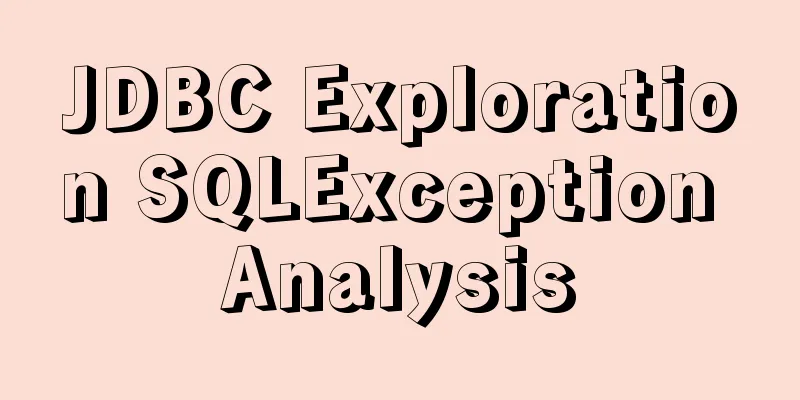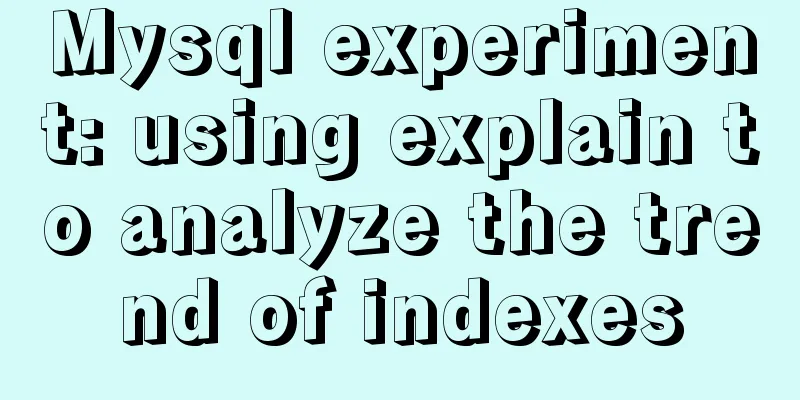JDBC Exploration SQLException Analysis

|
1. Overview of SQLException When an error occurs when using JDBC to interact with a data source (the data source in this article represents the database we actually use), an exception named SQLException will be thrown. A SQLException contains the following information to help us better locate the error. The error indicates: Use the getMessage method to get it. SQLState Code The code consists of five letters and numbers. Most of the codes are standardized by ISO/ANSI and the Open Group (X/Open), but there are still some codes implemented by database vendors themselves. Use the getSQLState method to obtain it. Error Code Unlike SQLState, error codes are integer values defined by the database provider, with the possibility of actual error codes returned by the underlying data source. Use the getErrorCode method to obtain it. Cause Indicates the cause of the exception. By continuously calling the getCause method, you can get the underlying cause of the exception. Exception Chain If multiple errors occur, the exceptions are referenced through this chain. Use the getNextException method to get it. 2. SQLException Example
public static void printSQLException(SQLException e){
for(Throwable e :ex){
if (e instanceof SQLException){
if (ignoreSQLException(((SQLException)e).getSQLState()) == false) {
e.printStackTrace(System.err);
System.err.println("SQLState: " + ((SQLException)e).getSQLState());
System.err.println("Error Code: " + ((SQLException)e).getErrorCode());
System.err.println("Message: " + e.getMessage());
Throwable t = ex.getCause();
while(t != null){
System.out.println("Cause : " + t);
t = t.getCause();
}
}
}
}
}
public static boolean ignoreSQLException(String sqlState){
if(sqlState == null){
System.out.println("The SQL state is not defined");
}
// X0Y32: Jar file already exists in schema
if (sqlState.equalsIgnoreCase("X0Y32")) {
return true;
}
// 42Y55: Table already exists in schema
if(sqlState.equalsIgnoreCase("42Y55")){
return true;
}
return true;
}Note: The above code is taken from [http:docs.oracle.com] (http://docs.oracle.com/javase/tutorial/jdbc/basics/sqlexception.html). 3. SQLWarning SQLWarning is a very important subclass of SQLException, used to indicate warnings that occur during database access. As an exception, a SQLWarning does not stop the execution of the application, but rather alerts the user that nothing is happening as planned. For example, a warning might notify you that an attempt to revoke a permission was unsuccessful, or inform you that an error might have occurred while requesting a disconnect. SQLWarning may be reported by Connection, Statement (including PreparedStatement and CallableStatement) or ResultSet. These classes all have a getWarnings method. Only by calling this method can you see the first warning reported on the calling object. If getWarning returns a warning, we can call its getNextWarning method to get the next warning. Each time a line of statements is executed, the warning of the previous line of statements will be cleared, which means that if we want to retrieve the warnings from the report processing, we must retrieve it before the next line of statements is executed. DataTruncation is the most common warning, with SQLState code 01004, indicating problems when reading or writing data. DataTruncation has many methods that help us understand which column or parameter data is truncated, whether the truncation is in the read or write operation, how many bytes should be transferred and how many bytes are actually transferred. 4. Other types of SQLException BatchUpdateException: Thrown when an error occurs during a batch update operation, in addition to the provided message, all statements that were killed before the error occurred are killed with the provided update count. SQLClientInfoException: Thrown when one or more client information properties cannot be set on a connection. In addition to the information provided, a list of client information properties that are not set is also provided. so on... Summarize The above is all the content of this article about SQLException parsing in JDBC exploration. I hope it will be helpful to you. Interested friends can continue to refer to this site: Summary of Common JDBC Interfaces, Code Examples of Using JDBC to Implement Data Access Object Layer (DAO), etc. If you have any questions, you can leave a message at any time. The editor will reply to you in time. Everyone is welcome to leave a message for discussion. You may also be interested in:
|
<<: Use pure JS to achieve the secondary menu effect
>>: VMware12.0 installation Ubuntu14.04 LTS tutorial
Recommend
Linux disk management LVM usage
1. Introduction to LVM When we manage Linux disks...
Use Rem layout to achieve adaptive
I have written an article about mobile adaptation...
7 cool dynamic website designs for inspiration
In the field of design, there are different desig...
A brief discussion on mobile terminal adaptation
Preface The writing of front-end code can never e...
Detailed explanation of HTML area tag
The <area> tag defines an area in an image ...
How to install Apache service in Linux operating system
Download link: Operating Environment CentOS 7.6 i...
Vue data responsiveness summary
Before talking about data responsiveness, we need...
How to maintain MySQL indexes and data tables
Table of contents Find and fix table conflicts Up...
HTML imitates Baidu Encyclopedia navigation drop-down menu function
HTML imitates the Baidu Encyclopedia navigation d...
Analysis of the process of building a cluster environment with Apache and Tomcat
In fact, it is not difficult to build an Apache c...
Three examples of blur background effects using CSS3
Let’s not start with the introduction and get str...
Analysis of the method of setting up scheduled tasks in mysql
This article uses an example to describe how to s...
Summary of common tool examples in MySQL (recommended)
Preface This article mainly introduces the releva...
How to Learn Algorithmic Complexity with JavaScript
Table of contents Overview What is Big O notation...
How to explain TypeScript generics in a simple way
Table of contents Overview What are Generics Buil...









